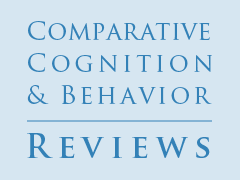Issues in the Comparative Cognition of Abstract-Concept Learning
by Jeffrey Katz,
Auburn University
Anthony A. Wright,
University of Texas Health Science Center at Houston
Kent Bodily,
Auburn University
Reading Options:
Download/Read PDF | Add to Endnote
Abstract
Abstract-concept learning, including same/different and matching-to-sample concept learning, provides the basis for many other forms of “higher” cognition. The issue of which species can learn abstract concepts and the extent to which abstract-concept learning is expressed across species is discussed. Definitive answers to this issue are argued to depend on the subjects’ learning strategy (e.g., a relational-learning strategy) and the particular procedures used to test for abstract-concept learning. Some critical procedures that we have identified are: How to present the items to-be-compared (e.g., in pairs), a high criterion for claiming abstract-concept learning (e.g., transfer performance equivalent to baseline performance), and systematic manipulation of the training set (e.g., increases in the number of rule exemplars when transfer is less than baseline performance). The research covered in this article on the recent advancements in abstract-concept learning show this basic ability in higher-order cognitive processing is common to many animal species and that “uniqueness” may be limited more to how quickly new abstract concepts are learned rather than to the ability itself.
Katz, J., Wright, A. A., & Bodily, K. (2007). Issues in the Comparative Cognition of Abstract-Concept Learning. Comparative Cognition & Behavior Reviews, 2, 79-92. Retrieved from https://comparative-cognition-and-behavior-reviews.org/ doi:10.3819/ccbr.2008.20005
